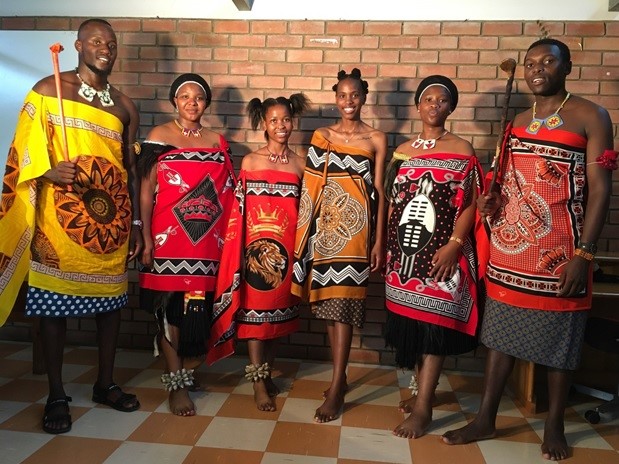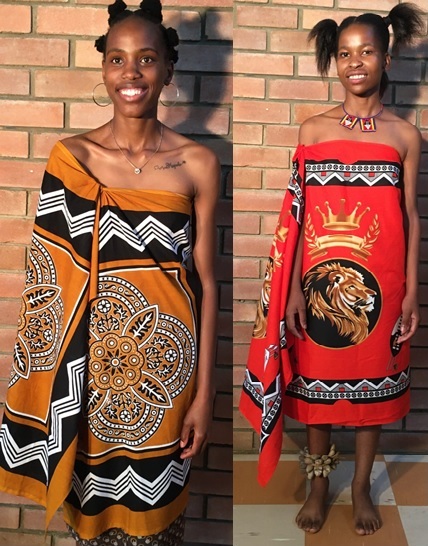The Karun Thakar Fund has awarded a Project Grant to the Textile and Apparel Design Faculty of the University of Eswatini, in support of their project ‘Traditional Emahiya attire as a template for preserving Eswatini history and culture.’ Here, Associate Professor Lodrick Makokha Wangatia introduces the university and the project.

Eswatini (formerly Swaziland) is a kingdom in Southern Africa, landlocked between South Africa in the north, west and south and Mozambique in the east. The University of Eswatini is the only public university in the kingdom. The university has eight faculties, and the department of Textile and Apparel Design (TAD) is under the Faculty of Consumer Sciences situated at the Luyengo Campus. The TAD Department offers both B.Sc. and M.Sc programmes in textiles; a Bachelor of Science in Textile and Apparel Design and Management, and Master of Science in Textiles respectively. The department has facilities where both students and staff engage in research work. Over the years the department has successfully been involved in innovative textile-based research work with results being recognised at various national and international forums.

‘A people without knowledge of their history, origin and culture is like a tree without roots’
Marcus Garvey
These are the famous words spoken by Marcus Garvey. Eswatini, like other countries, is fast losing its history and culture with changing times. In the past, the youth used to spend time with the old, listening to stories that had so much reference to Eswatini culture and history. However, with the repercussions of modernisation and lack of interest, young people no longer have time for engaging the old to learn their history. This trend may potentially cause significant loss of culture and history of the Swati people in the generations to come. New and innovative methods need to be adapted to foster the preservation and transmission of Swati culture.
The Eswatini traditional cloth lihiya (singular) or emahiya (plural) is the main form of traditional cloth worn by Emaswati (the people of Eswatini) of different genders and age groups for different ceremonies. Lihiya is a plain woven, rectangular piece of cotton fabric (1.5 x 2m). The emahiya have central motifs, often with borders printed on brightly coloured background. The traditionally-inspired simple motifs are usually used for both the back and front of the cloth. The designs of the motifs have evolved from common abstract to ceremonial connotations and artefacts of cultural significance. However, there has been minimal effort to use emahiya and its prints as a vehicle to tell the history of Emaswati. Such efforts are reflected in the use of the lion and elephant, which are symbolic of the King and Queen Mother, and their portraits as motifs for emahiya. There is therefore room to explore how other images might be used to reveal – and even preserve – the Eswatini Swati culture on emahiya.

The ‘Traditional Emahiya attire as a template for preserving Eswatini history and culture’ project intends to find a simpler way of passing on culture and history to new generations of Eswatini people through textile print design. This endeavour will be realised by preparing unique and attractive prints that have some relevance to the culture and history of the Eswatini people, as well as the fauna and flora of the country. In addition to the educational and preservation aspects, the prints will also serve to provide an avenue for local fine artists and textile designers to share their design skills with the world. Elderly people play an important role in any community as custodians of history, culture and traditions. This project will make engage the help of older people in communities to capture the country’s history, which will be translated into motifs that tell stories through the emahiya.

As a further effort to preserve the original emahiya which were dyed using natural dyes, the project intends to make use of natural dye colourants from local plants to make the emahiya. There is an appreciation that natural dyes, as much as they have a wide range of advantages, also have some short comings, like poor shades. Technology has brought about many changes in the textile industry, therefore to help improve on the quality of the dyed and printed emahiya, nanomaterials will be used in their dyeing and printing.
Upon succeeding to efficiently dye and print our emahiya with the unique prints, we plan to pass on the knowledge and skills to local emahiya makers. This will be done by organising training activities in the four regions of the country under with the assistance of the Ministry of Commerce and Industry: Handicraft section.



As a Swazi, I’m a bit disappointed by the failure to mention colonialism at least once instead of chalking up the loss of indigenous knowledge to “modernisation”.
How can you mention the boy’s attire and miss emajobo , it is like going naked for the boys. your picture dont even show emajobo. how is that possible?
Our project’s focus is only limited to lihiya as a vehicle for the preservation of knowledge. I’m afraid that not all the elements of the traditional attire are covered, and the emajobo (which is the animal-skin loin skirt) worn by boys and men, is outside our focus.
Colonization may have played part in early days, yes, but our experience is that the current generation is very focused on their current lives. Our focus for this project is simply the lack of existing frameworks to promote culture preservation. There is a complex background to the position we take, and I appreciate your thoughts.